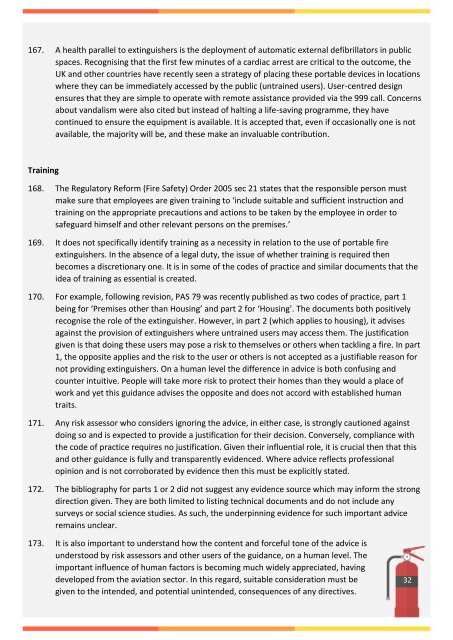An evaluation of the role of fire extinguishers
A report considering the role of a fire extinguisher in human terms identifying the gap between policy assumptions and the evidence from real fires. It considers the implications arising from this and makes a number of recommendations to create an evidence base and enhance current fire safety policies/advice.
A report considering the role of a fire extinguisher in human terms identifying the gap between policy assumptions and the evidence from real fires. It considers the implications arising from this and makes a number of recommendations to create an evidence base and enhance current fire safety policies/advice.
You also want an ePaper? Increase the reach of your titles
YUMPU automatically turns print PDFs into web optimized ePapers that Google loves.
167. A health parallel to <strong>extinguishers</strong> is <strong>the</strong> deployment <strong>of</strong> automatic external defibrillators in public<br />
spaces. Recognising that <strong>the</strong> first few minutes <strong>of</strong> a cardiac arrest are critical to <strong>the</strong> outcome, <strong>the</strong><br />
UK and o<strong>the</strong>r countries have recently seen a strategy <strong>of</strong> placing <strong>the</strong>se portable devices in locations<br />
where <strong>the</strong>y can be immediately accessed by <strong>the</strong> public (untrained users). User-centred design<br />
ensures that <strong>the</strong>y are simple to operate with remote assistance provided via <strong>the</strong> 999 call. Concerns<br />
about vandalism were also cited but instead <strong>of</strong> halting a life-saving programme, <strong>the</strong>y have<br />
continued to ensure <strong>the</strong> equipment is available. It is accepted that, even if occasionally one is not<br />
available, <strong>the</strong> majority will be, and <strong>the</strong>se make an invaluable contribution.<br />
Training<br />
168. The Regulatory Reform (Fire Safety) Order 2005 sec 21 states that <strong>the</strong> responsible person must<br />
make sure that employees are given training to ‘include suitable and sufficient instruction and<br />
training on <strong>the</strong> appropriate precautions and actions to be taken by <strong>the</strong> employee in order to<br />
safeguard himself and o<strong>the</strong>r relevant persons on <strong>the</strong> premises.’<br />
169. It does not specifically identify training as a necessity in relation to <strong>the</strong> use <strong>of</strong> portable <strong>fire</strong><br />
<strong>extinguishers</strong>. In <strong>the</strong> absence <strong>of</strong> a legal duty, <strong>the</strong> issue <strong>of</strong> whe<strong>the</strong>r training is required <strong>the</strong>n<br />
becomes a discretionary one. It is in some <strong>of</strong> <strong>the</strong> codes <strong>of</strong> practice and similar documents that <strong>the</strong><br />
idea <strong>of</strong> training as essential is created.<br />
170. For example, following revision, PAS 79 was recently published as two codes <strong>of</strong> practice, part 1<br />
being for ‘Premises o<strong>the</strong>r than Housing’ and part 2 for ‘Housing’. The documents both positively<br />
recognise <strong>the</strong> <strong>role</strong> <strong>of</strong> <strong>the</strong> extinguisher. However, in part 2 (which applies to housing), it advises<br />
against <strong>the</strong> provision <strong>of</strong> <strong>extinguishers</strong> where untrained users may access <strong>the</strong>m. The justification<br />
given is that doing <strong>the</strong>se users may pose a risk to <strong>the</strong>mselves or o<strong>the</strong>rs when tackling a <strong>fire</strong>. In part<br />
1, <strong>the</strong> opposite applies and <strong>the</strong> risk to <strong>the</strong> user or o<strong>the</strong>rs is not accepted as a justifiable reason for<br />
not providing <strong>extinguishers</strong>. On a human level <strong>the</strong> difference in advice is both confusing and<br />
counter intuitive. People will take more risk to protect <strong>the</strong>ir homes than <strong>the</strong>y would a place <strong>of</strong><br />
work and yet this guidance advises <strong>the</strong> opposite and does not accord with established human<br />
traits.<br />
171. <strong>An</strong>y risk assessor who considers ignoring <strong>the</strong> advice, in ei<strong>the</strong>r case, is strongly cautioned against<br />
doing so and is expected to provide a justification for <strong>the</strong>ir decision. Conversely, compliance with<br />
<strong>the</strong> code <strong>of</strong> practice requires no justification. Given <strong>the</strong>ir influential <strong>role</strong>, it is crucial <strong>the</strong>n that this<br />
and o<strong>the</strong>r guidance is fully and transparently evidenced. Where advice reflects pr<strong>of</strong>essional<br />
opinion and is not corroborated by evidence <strong>the</strong>n this must be explicitly stated.<br />
172. The bibliography for parts 1 or 2 did not suggest any evidence source which may inform <strong>the</strong> strong<br />
direction given. They are both limited to listing technical documents and do not include any<br />
surveys or social science studies. As such, <strong>the</strong> underpinning evidence for such important advice<br />
remains unclear.<br />
173. It is also important to understand how <strong>the</strong> content and forceful tone <strong>of</strong> <strong>the</strong> advice is<br />
understood by risk assessors and o<strong>the</strong>r users <strong>of</strong> <strong>the</strong> guidance, on a human level. The<br />
important influence <strong>of</strong> human factors is becoming much widely appreciated, having<br />
developed from <strong>the</strong> aviation sector. In this regard, suitable consideration must be<br />
given to <strong>the</strong> intended, and potential unintended, consequences <strong>of</strong> any directives.<br />
32<br />
0




